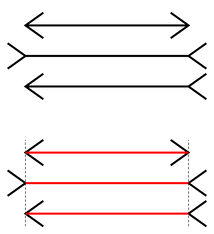
It’s hard to be a fan of VAR with its many quirks. At times it is as if the lines are drawn with MS paint.
As fans and pundits rage online on a weekly basis over VAR calls, one part of me does have sympathy for those administrating VAR. Our eyes can deceive us. When we think a player is onside, in fact they may not be. Visual illusions are a mainstay of introductions to behavioural economics – they usually set things up nicely for discussing information-based biases – it follows that if you can’t trust your eyes what else can’t you trust?
Unsurprisingly, Daniel Kahenman offers a nice insight in Thinking Fast and Slow when discussing the famous Müller-Lyer illusion inset.
“You know that the lines are equally long. If asked about their length, you will say what you know. But you still see the [middle] line as longer. You have chosen to believe the measurement, but you cannot prevent System 1 from doing its thing; you cannot decide to see the lines as equal, although you know they are. To resist the illusion, there is only one thing you can do: you must learn to mistrust your impressions of the length of lines when fins are attached to them. To implement that rule, you must be able to recognize the illusory pattern and recall what you know about it. If you can do this, you will never again be fooled by the Müller-Lyer illusion. But you will still see one line as longer than the other.”
Is it time to start trusting the technology? As we are often reminded on TV, us viewers only see one angle. Or at least, should we start recognising that our perceptions might be fallible?
Accepting our intuition failures might be easy for the Müller-Lyer paradox, but this is harder for sport. Fans have clear allegiances and are emotionally engaged. System 2 has to work even harder!
 RSS Feed
RSS Feed